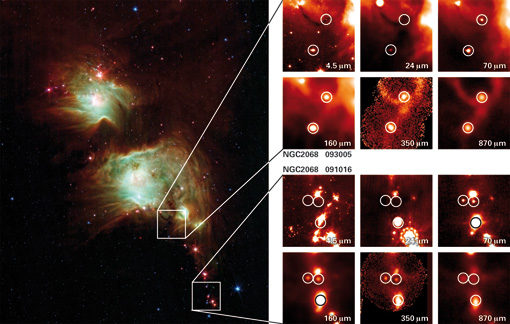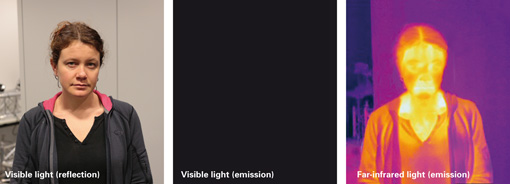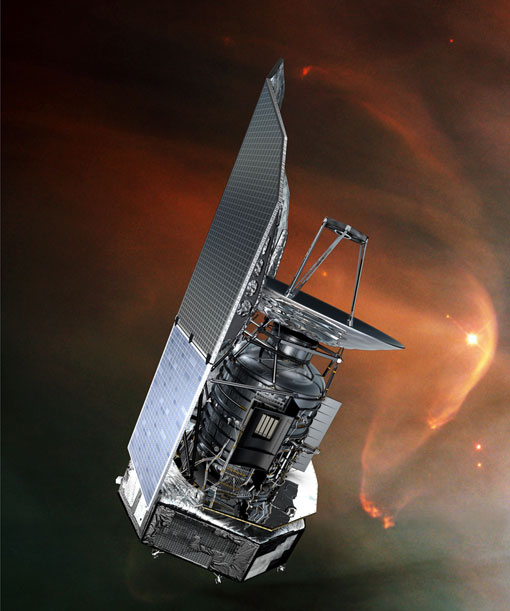|
|
MPIA Science Release 2013-03 |
|
| German version |
In Orion, Herschel finds the youngest stars yet
A group of astronomers led by Amelia Stutz of the Max Planck Institute for Astronomy in Heidelberg has used both the Herschel Space Observatory and the submillimeter telescope APEX to discover and characterize the youngest known protostars yet: stellar embryos still deeply embedded in unexpectedly dense dust cocoons. The discovery promises new insights into the earliest stages of star formation, and consequently into the way our home star, the Sun, came into being. The work will be published in the Astrophysical Journal.
 |
Figure 1: Three of the PACS Bright Red Sources (PBRS) found with the Herschel Space Observatory, which appear to be among the youngest known protostars. The leftmost panel shows an image taken with the Spitzer Space Telescope (at 24 µm) in which the upper two objects are completely invisible, while the lower one is not clearly identifiable as a protostar. The two panels on the right show images taken with the Herschel Space Observatory (at 70 µm) and with the APEX submillimeter telescope (at 350 µm), which allowed for the identification of all three objects as some of the earliest known protostars yet. Credit: A. M. Stutz (MPIA) Larger version for download] |
| Contact | Background information | Questions and Answers | Images |
Stars are born in hiding, behind layers of dust, deep within the clouds of molecular gas whose collapse brings them into existence. The younger a star-to-be (or "protostar"), the more difficult it is to observe. Over the past years, using ever more advanced infrared technology, there has been a veritable race for finding protostars in ever earlier stages of development. Now, a group of astronomers led by Amelia Stutz of the Max Planck Institute for Astronomy has used both the Herschel Space Observatory and the submillimeter telescope APEX to discover and characterize the youngest known protostars yet.
Team member Tom Megeath of the University of Toledo, Ohio, recalls: "The discovery was totally serendipitious. I was looking at images taken with the space telescopes Spitzer and Herschel, showing a recently discovered interesting protostar in Orion, which is varying in brightness. In the first Herschel image I looked at, sure enough, there was the protostar – but there was another object right next to it! That second object hadn't shown up in the images taken at shorter wavelengths with the Spitzer telescope."
For physicists, the fact that an object shines brightly at longer wavelengths, but is invisible at shorter wavelengths, holds specific clues as to the object's temperature. Human beings for instance, with their body temperatures of around 37 degrees Celsius, emit infrared light, but not visible light. For the Herschel image, the researchers concluded that they could be looking at an exceptionally cool protostar. This was an exciting prospect, since at such low temperatures, this would be a protostar in a much earlier developmental stage than anyone had ever seen before!
After this first compelling discovery, Stutz then carefully combed through the data looking for more examples of other similar specimens in Orion. They ended up with a total of 55 of these apparently very cold objects.
But the universe has one additional trick up its sleeve. Very distant cosmic objects appear "redshifted", which can make a very distant ordinary galaxy look like a very cold nearby protostar. Stutz explains: "We needed to separate the protostars from the impostors. And we knew that would only be possible with more data. That's why we went to APEX, which can receive light at even longer wavelengths than Herschel." The APEX antenna is located in the Atacama desert in Chile and operated by the European Southern Observatory (ESO).
With the combined data, and carefully comparing their observations with physical models of protostars and similar objects, Stutz and her colleagues narrowed their list to 15 reliably identified new protostars. They dubbed the reddest sources "PACS Bright Red Sources", PBRS for short, after the Herschel instrument PACS whose images had led to their discovery in the first place. These sources where not identifiable as protostars by the Spitzer telescope due to their low temperature – a number of them are simply invisible in the Spitzer images.
Going by the analysis of Stutz and her colleagues, these are the youngest protostars yet observed: dusty gas envelopes with masses between 1/5 and 2 times that of the Sun, heated to about 20 degrees Celsius above absolute zero (20 K) by a protostar hidden deep inside.
Stutz on the implications of their find: "The earliest stages are where the protostar builds up most of its mass. But they're also hardest to observe. Up until now, when a theorist built a model of star formation, there was no direct way of comparing what the model said about the earliest stages with observation. Now we're closing that gap – and that's always a good thing if you want to know what's really going on."
For Stutz and their colleagues, the next stages in their campaign are already underway: Follow-up observations with Herschel on eight of the PBRS to look for traces of the gas outflows predicted for these early prototypes, and observations using the Green Bank Telescope of light characteristic for denser regions populated by gas molecules. The astronomers also hope for observation time on ALMA, the array of submillimeter antennae currently under construction in the Atacama desert: ALMA should be able to reveal finer details of the envelopes, and allow for more precise measurements of their densities.
Stutz concludes: "It's always exciting to find new kinds of objects such as our PBRS – in particular when they promise information about something as fundamental as the birth of stars. And both our discovery and the potential for future follow-up show that these are interesting times to be an astronomer. Without Herschel, we would have missed these sources altogether. With facilities like ALMA we will be able to examine them in unprecedented detail."
| top |
Contact information
Amelia Stutz (first author)
Max Planck Institute for Astronomy
Heidelberg, Germany
Phone: (+49|0) 6221 – 528 412
Email: stutz@mpia.de
Axel M. Quetz (public relations)
Max Planck Institute for Astronomy
Heidelberg, Germany
Phone: (+49|0) 6221 – 528 158
Email: pr@mpia.de
| top |
Background information
The work described here was published as A. Stutz et al., "A Herschel and APEX census of the reddest sources in Orion: Searching for the youngest protostars" in the Astrophysical Letters.
• Original article (ADS entry)
The co-authors are A. M. Stutz (MPIA), J. J. Tobin (National Radio Astronomy Observatory), T. Stanke (ESO), S. T. Megeath and W. J. Fischer (both: University of Toledo), T. Robitaille and T. Henning (both: MPIA), B. Ali (NHSC/IPAC/Caltech), J. Di Francesco (National Research Council of Canada, Herzberg Institute of Astrophysics, University of Victoria), E. Furlan (National Optical Astronomy Observatory, NHSC/IPAC/Caltech), L. Hartmann (University of Michigan), M. Osorio (Instituto de Astrofísica de Andalucía), T. L. Wilson (Naval Research Laboratory), L. Allen (National Optical Astronomy Observatory), O. Krause (MPIA) and P. Manoj (University of Rochester).
The Herschel observations were part of the Herschel Orion Protostar Survey (HOPS), whose principal investigator is Tom Megeath (University of Toledo).
Herschel is an ESA space observatory with science instruments provided by European-led Principal Investigator consortia and with important participation from NASA. PACS has been developed by a consortium of institutes led by MPE (Germany) and including: UVIE (Austria); KU Leuven, CSL, IMEC (Belgium); CEA, LAM (France); MPIA (Germany); INAF-IFSI/OAA/OAP/OAT, LENS, SISSA (Italy); IAC (Spain). This development has been supported by the funding agencies BMVIT (Austria), ESA-PRODEX (Belgium), CEA/CNES (France), DLR (Germany), ASI/INAF (Italy), and CICYT/MCYT (Spain).
APEX is a collaboration between the Max Planck Institute for Radio Astronomy (MPIfR), the Onsala Space Observatory (OSO) and ESO. Operation of APEX at Chajnantor is entrusted to ESO. APEX is a pathfinder for the next-generation submillimetre telescope, the Atacama Large Millimeter/submillimeter Array (ALMA), which is being built and operated on the same plateau.
NASA's Jet Propulsion Laboratory, Pasadena, Calif., manages the Spitzer Space Telescope mission for NASA's Science Mission Directorate, Washington. Science operations are conducted at the Spitzer Science Center at the California Institute of Technology in Pasadena. Data are archived at the Infrared Science Archive housed at the Infrared Processing and Analysis Center at Caltech. Caltech manages JPL for NASA.
| top |
Questions and Answers
What is the significance of observing these objects at so many different wavelengths?
The so-called thermal radiation objects emit due to their temperature is governed by simple physical laws. Cold objects radiate predominantly at very long wavelengths. When talking about visible light, these lie towards the red end of the spectrum: colder objects are redder.
It is not usual for a cold object to be invisible at shorter wavelengths and only detectable at longer ones. We know this from everyday life comparing a hot object, namely an incandescent bulb, with a comparatively cold object, a human body: An incandescent bulb, its filament heated to about 3400 degrees Celsius, produces sizeable amounts of visible light, showing up clearly on a photograph taken in an otherwise dark room. Without an additional light-source, a human being, however, will not show up on such a photograph, since humans do not radiate visible light. But at a body temperature of around 37 degrees Celsius, a human will emit infrared radiation, and show up on an image taken with a long-wavelength infrared camera.
At a mere 20 K, corresponding to 20 degrees Celsius above absolute zero, the PBRS are so cold that they do not emit sufficient radiation to be detected by the Spitzer infrared space telescope. They do, however, show clearly on measurements with the Herschel space Observatory and with APEX at even longer wavelengths.
Which telescopes and instruments were used in the study?
The initial observations used the instrument PACS ("Photodetector Array Camera & Spectrometer") aboard the Herschel Space Observatory at wavelengths of 70 and 160 µm. PACS is a combination of camera and spectrograph for wavelengths between 57 and 210 µm. The instrument was developed and constructed by a consortium led by the Max Planck Institute for Extraterrestrial Physics in Garching, with key contributions by the Max Planck Institute for Astronomy in Heidelberg.
PACS images were compared with images taken with NASA's Spitzer Space telescope: with the infrared camera IRAC at 4.5 µm and with the far-infrared detector array MIPS at 24 µm.
Additional observations were then made with APEX, specifically with the camera SABOCA at 350 µm and the the camera LABOCA at 870 µm. APEX, the Atacama Pathfinder Experiment telescope, is a 12-metre diameter telescope, operating at millimetre and submillimetre wavelengths. ESO operates the APEX at one of the highest observatory sites on Earth, at an elevation of 5100 metres, high on the Chajnantor plateau in Chile's Atacama region.
| top |
 |
||
Figure 2: The large-scale image shows the reflection nebula M 78, or NGC 2068, in the constellation Orion, imaged with the Spitzer Space Telescope. Blue represents 3.6 µm and 4.5 µm light and green shows light of 5.8 µm and 8 µm, both captured by Spitzer's infrared array camera IRAC. Red represents 24 µm light detected by Spitzer's multiband imaging photometer MIPS. The smaller-scale images show a total of five of the PACS Bright Red Sources (PBRS) discovered by Stutz et al. Their status as very young and dense protostars could not be determined without Herschel and APEX, and some of the sources are not even visible in the Spitzer images. At longer wavelengths (70 µm and 160 µm with Herschel-PACS, 350 µm and 870 µm with the APEX telescope) they shine brightly, as would be expected for very cold objects. Their low temperatures are the key to identifying these objects as protostars in the earliest stages currently known. Credit: A. M. Stutz (MPIA) [Larger version for download] |
||
 |
||
Figure 3: Cooler objects emit light at longer wavelengths, and may be invisible at shorter one. This series of images shows team leader Amelia M. Stutz in the reflected light produced by an incandescent bulb (left image). Dr. Stutz' temperature is not sufficiently high to emit significant amounts of visible light; in the absence of an external light source, she remains invisible (middle image). However, like all humans, Dr. Stutz emits far-infrared light, at far longer wavelengths than those of visible light, that can be imaged with a thermal camera (right image). Hence, just like the objects she discovered, Dr. Stutz remains invisible at shorter wavelengths and shows up on images taken at longer wavelengths. Credit: M. Pössel (MPIA) [Larger version for download] |
||
| Figure 4: The Herschel Space Observatory (artist's impression). Credit: ESA [Larger version for download] |
 |
|
| top | ||
Images
 |
PR_2013_03_1.jpg | JPG | RGB | 510 x 162 pxl 72 dpi |
49 KB |
| PR_2013_03_1gr.jpg | JPG | RGB | 1200 x 380 pxl 72 dpi |
156 KB | |
| PR_2013_03_1.pdf | CMYK | – | 1,6 MB | ||
 |
PR_2013_03_2.jpg | JPG | RGB | 510 x 324 pxl 72 dpi |
86 KB |
| PR_2013_03_2gr.jpg | JPG | RGB | 1200 x 763 pxl 72 dpi |
336 KB | |
| PR_2013_03_2.pdf | CMYK | – | 1,0 MB | ||
 |
PR_2013_03_3.jpg | JPG | RGB | 510 x 184 pxl 72 dpi |
33 KB |
| PR_2013_03_3gr.jpg | JPG | RGB | 1200 x 432 pxl 72 dpi |
102 KB | |
| PR_2013_03_3.pdf | CMYK | – | 15,8 MB | ||
 |
PR_2013_03_4.jpg | JPG | RGB | 510 x 611 72 dpi |
57 KB |
| PR_2013_03_4gr.jpg | JPG | RGB | 1000 x 1198 72 dpi |
197 KB | |
| PR_2013_03_4hr.jpg | JPG | RGB | 2000 x 2395 72 dpi |
610 KB | |
Press Releases 2013